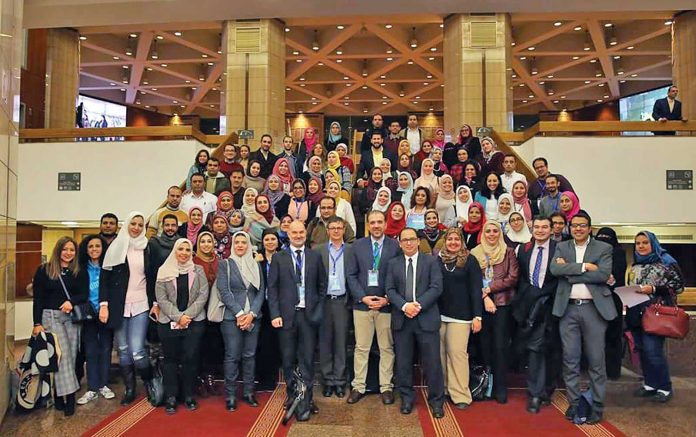By C.A.I.R.O Journal Club Executive Board
Posted: December 2018
Egypt faced major turmoil in 2011, with subsequent dramatic political changes and a rapidly developing economic crises that, within a few months, led to a significant increase in the proportion of the population living below the poverty line. As per the World Bank, Egypt is defined as a lower-middle–income country with a gross national income per capita of US$1,006 to US$3,955. Despite the fact that Egypt is grouped with countries such as India, Morocco, Indonesia, Sudan, Yemen, and Myanmar in this classification, it is clearly visible that the gross national income per capita is not a reliable index for healthcare quality.1 These countries each face several diverse obstacles challenging their goal to provide high-quality healthcare for their citizens. Egypt, for example, has one of the highest gross number of oncologists and cancer centers in the Middle East and Africa; however, it has one of the lowest health expenditures per capita compared to other lower-middle–income countries.
Such economic challenges mostly affect the disciplines with rapidly evolving diagnostic and therapeutic advances—the top of which is NSCLC. The number of specialized healthcare providers and facilities can barely deliver basic care for the population of more than 95 million. In addition, several university hospitals and dedicated cancer centers that had previously met the basic needs for lung cancer treatment according to the past decade’s standards are now falling short according to today’s standards.
Lung cancer represents the most lethal malignancy in Egypt (similar to most countries); however, it is the fourth most common cancer in men, and it is relatively rare in women.2 This gender difference in incidence is mainly due to differences in tobacco smoking rates. According to Giovino et al.,3 Egypt remains one of the countries with the lowest percentages of female smokers in the world. Egypt does not have a national screening program, and most patients present with either locally advanced or metastatic disease.
Barriers to Lung Cancer Care
Heterogeneity in the level of diagnostic and therapeutic options remains the crux of the lung cancer problem in Egypt. There are three large categories of oncology practice in Egypt.
The first and largest are the public governmental hospitals, which offer full reimbursement for all basic diagnostic and therapeutic interventions. These hospitals (which include dedicated cancer centers, university hospitals, and Ministry of Health public hospitals) serve more than half of all patients with lung cancer in Egypt and offer standard chemotherapeutic agents (pemetrexed and targeted agents are not reimbursed for NSCLC treatment; however, pemetrexed is available for patients with mesothelioma), standard 3D radiation therapy, cardiothoracic surgery, and palliative care.
Second is the public insurance sector, which allows for the same standard options provided by the public hospitals in addition to limited additional diagnostics (including baseline PETCT) and therapeutic options (including pemetrexed [for both malignant pleural mesothelioma and NSCLC] and EGFR tyrosine-kinase inhibitors [TKIs] in second-line treatment). The authors estimate that somewhere in the range of 35% to 40% of patients receive this type of care.
Finally, there are private hospitals/clinics that cater to out-of-pocket payers and those with national and international private insurance coverage, where patients have access to further biology-driven therapies such as EGFR and ALK TKIs, bevacizumab, and immune checkpoint inhibitors. The authors estimate that no more than 10% of patients receive this type of care.

Can We Enhance Our Existing Resources?
Despite the limitation in the governmental health expenditure, many resources can be optimized to provide state-of-the-art cancer care at no additional cost. First, across the three major oncology service categories, fewer than 10% of all patients with lung cancer have access to a multidisciplinary team. This is mainly caused by nonuniform distribution of oncology specialists across different regions in Egypt. Redistribution of oncologists, radiation oncologists, thoracic surgeons, and other related healthcare providers could significantly improve the quality of lung cancer care. Second, dedicated palliative care units are scarce in Egypt. Investing in this extremely important service, which has been proven to improve quality of life, symptom severity, depression, and possibly survival, is a must.4 Third, some molecular tests (such as EGFR mutations and ALK rearrangement) are already sponsored by the pharmaceutical industry. Increasing awareness among oncologists could increase the number of patients tested (which stands currently at only approximately 20% of all patients) and, hence, allow more diverse treatment options. Fourth, renegotiating TKI prices to be covered by the Ministry of Health reimbursement system could provide cost-effective patient care that could reduce the number of clinic visits and inpatient admissions in already-crowded cancer care facilities. Finally, by encouraging international multicenter clinical trials testing new agents, many patients could gain access to unavailable drugs free of charge. In addition, such trials could help define subgroups that benefit the most from newer agents and, hence, could offer the opportunity for smart, cost-effective personalization of care.
For example, immunotherapy costs the United States US$174 billion per year.5 Recently, several voices have been pressuring low- and middle-income countries’ health authorities to adopt recent advances such as immunotherapy and newer-generation TKIs into the reimbursement system. Such expansion should be cautiously considered.
In a country where tobacco and occupational exposures are the main cause of lung cancer, directing resources toward anti-tobacco campaigns and early detection among high-risk populations should also be considered a priority. In our opinion, centralization of the therapeutic policies via national guidelines and decentralization of the services provided through well-distributed, dedicated thoracic multidisciplinary teams could help decrease cancer-related suffering on an individual and country-wide level. ✦
|
|
References:
1. Data: World Bank Country and Lending Groups. The World Bank website. datahelpdesk.worldbank.org/knowledgebase/articles/906519-worldbank-country-and-lending-groups. Accessed March 28, 2018.
2. Ibrahim AS, Khaled HM, Mikhail NN, Baraka H, Kamel H. Cancer incidence in Egypt: results of the national population-based cancer registry program. J Cancer Epidemiol. 2014;2014:437971.
3. Giovino GA, Mirza SA, Samet JM, et al. Tobacco use in 3 billion individuals from 16 countries: an analysis of nationally representative cross-sectional household surveys. Lancet. 2012;380(9842):668-679.
4. Haun MW, Estel S, Rucker G, et al. Early palliative care for adults with advanced cancer. Cochrane Database Syst Rev. 2017 Jun 12;6:CD011129.
5. Andrews A. Payers’ Perspectives in Oncology American health and drug benefits. American Health & Drug Benefits. 2015;8(Special issue).











